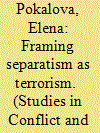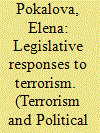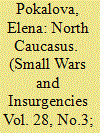|
|
|
Sort Order |
|
|
|
Items / Page
|
|
|
|
|
|
|
| Srl | Item |
| 1 |
ID:
159899


|
|
|
|
|
| Summary/Abstract |
Al Qaeda leaders have consistently praised the Chechen insurgents as an exemplary front of global jihad. Ayman al-Zawahiri recently applauded the steadfastness of the Chechen rebels and indicated that their resolve for jihad is worthy of emulation. Ever since the world found out about a war going on in the Muslim republic in the North Caucasus, Al Qaeda leadership has attempted to represent the Chechen struggle as one of its own battlefields. In turn, the Russian government has tried to justify its policies in the North Caucasus through demonstrating to the world that the Kremlin is fighting nothing less than Osama bin Laden’s agents in Chechnya. The North Caucasus insurgents in turn have embraced some of Al Qaeda’s narratives. While such narratives have proliferated, the factual evidence to show the direct links between the North Caucasus insurgents and Al Qaeda is still lacking. The article examines how terrorist groups such as Al Qaeda use framing for strategic ends. The evidence discussed here suggests that Al Qaeda, the North Caucasus insurgents, and the Russian government have adopted similar narratives. However, the lack of evidence to back up such narratives indicates the differences in reasons driving the convergence of the narratives.
|
|
|
|
|
|
|
|
|
|
|
|
|
|
|
|
| 2 |
ID:
168900


|
|
|
|
|
| Summary/Abstract |
With the rise of the self-proclaimed Islamic State of Iraq and Syria (ISIS), the phenomenon of foreign fighters became a significant security concern. Governments around the world have become preoccupied with the possibility of their citizens leaving for combat zones and then coming back with training and experience. While previously foreign fighters participated in such conflicts as Afghanistan, Bosnia, or Chechnya, today ISIS has attracted record numbers of individuals from various backgrounds. This article examines factors that might be connected with the outflow of foreign fighters to Syria and Iraq. The analysis is based on 190 countries with 103 of them serving as countries of origin for 33,815 foreign fighters. Negative binomial regression is used to evaluate the connection of political, economic, demographic, and social factors to numbers of foreign fighters. The findings indicate that more foreign fighters come from countries with higher Human Development Index levels, unemployment rates, percentages of youth, population size, percentages of Muslim population, emigration levels, Internet penetration, and the presence of Al Qaeda cells. However, the findings further indicate that the effect of these variables is not uniform across majority Muslim and majority non-Muslim countries.
|
|
|
|
|
|
|
|
|
|
|
|
|
|
|
|
| 3 |
ID:
096150


|
|
|
|
|
| Publication |
2010.
|
| Summary/Abstract |
Framing separatism as terrorism presents numerous opportunities for governments facing ethno-nationalist challenges. Namely, such framing allows states to avoid addressing the ethno-nationalist roots of separatist conflicts. This article analyzes incentives and opportunities that terrorism presents for states involved in ethno-nationalist separatist conflicts. The article investigates how the framing dynamics proved to be successful in the cases of the Kurdish and Chechen separatist conflicts. The case of Kosovo is examined as illustrative of a different outcome: the international presence in the Kosovo conflict made it substantially different from the previous cases and served as an intervention in the Serbian framing dynamics.
|
|
|
|
|
|
|
|
|
|
|
|
|
|
|
|
| 4 |
ID:
174395


|
|
|
|
|
| Summary/Abstract |
The Islamic State in Iraq and Syria (ISIS) has attracted many foreign fighters from all over the world. ISIS has disseminated voluminous propaganda in painting itself as the defender of Islam. The core of ISIS messages is designed to have a global religious appeal. At the same time, ISIS has incorporated local issues and grievances into its propaganda message. The analysis of Georgia's experiences with foreign fighters reveals that ISIS has exploited local issues to attract recruits, demonstrating that, even though foreign fighter recruitment seems global, it inevitably draws on local roots.
|
|
|
|
|
|
|
|
|
|
|
|
|
|
|
|
| 5 |
ID:
139997


|
|
|
|
|
| Summary/Abstract |
Recent years have witnessed a significant increase in the amount of counterterrorism legislation worldwide. The commonly held assumption behind the adoption of counterterrorism legislation links it to the terrorist threat in a state. However, little research has focused on empirically testing reasons driving states to legislate. This article addresses this void by analyzing the puzzle of why states choose to adopt new terrorism-specific legislation. The article presents empirical analysis of the probability of states to legislate before and after September 11, 2001, and is based on a new database of counterterrorism legislation. The findings reveal that before September 11, state decisions to adopt new legislation correlated with the number of terrorist organizations operating in their territory. Since September 11, however, the most significant predictors for the adoption of new legislation have become the existence of previous counterterrorism legislation and the participation of a state in the War on Terror.
|
|
|
|
|
|
|
|
|
|
|
|
|
|
|
|
| 6 |
ID:
178472


|
|
|
|
|
| Summary/Abstract |
In 2013, international news headlines started referencing Georgian Tarkhan Batirashvili, or Omar al-Shishani, as a rising star among foreign fighters in the Islamic State of Iraq and Syria (ISIS). At the time, it was puzzling why a Georgian Kist would fight for ISIS. However, following al-Shishani, around 200 other residents of Georgia’s Pankisi Gorge travelled to Syria and Iraq. The trend raised numerous questions about radicalization in this country with very limited experience with terrorism. This article examines why so many Pankisi Kists departed for Syria and Iraq. Specifically, we analyse the impact of the neighbouring insurgencies in the North Caucasus and examine how the Chechen conflicts shaped the emergence of radicalism in Georgia’s Pankisi Gorge. The article traces how the movement of individuals, equipment and ideas to and from Chechnya impacted the Muslim identity of the local population in Pankisi.
|
|
|
|
|
|
|
|
|
|
|
|
|
|
|
|
| 7 |
ID:
152966


|
|
|
|
|
| Summary/Abstract |
Insurgencies have proven to be highly adaptive movements that exploit their environments and change and mutate in order to survive. States and international actors have long grappled with ways to thwart such adaptations. In this respect, disengagement initiatives that offer insurgents opportunities for alternative livelihood seem to present a viable mechanism for weakening insurgencies. Analyzing the case of the North Caucasus insurgency, this article examines the interrelation between such variables as insurgent crises, government disengagement programs, and foreign attempts to co-opt the insurgency. It is argued that disengagement programs implemented during the second Chechen conflict prevented the insurgent command from pledging allegiance to Al-Qaeda because insurgents had to preserve their local orientation to compete for their bases of support. In 2014, however, the North Caucasus insurgents pledged allegiance to the Islamic State of Iraq and Syria as no viable disengagement opportunities existed at the time and their only route for survival was to join a global insurgency.
|
|
|
|
|
|
|
|
|
|
|
|
|
|
|
|
|
|
|
|
|